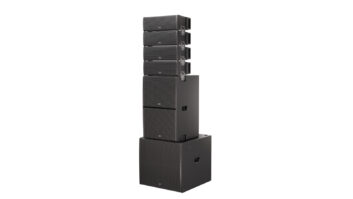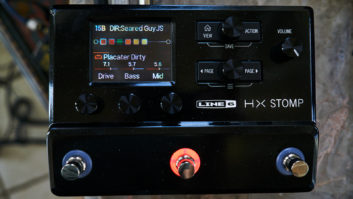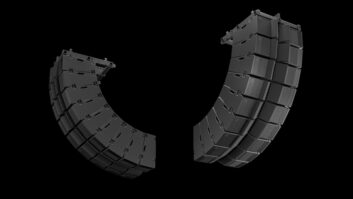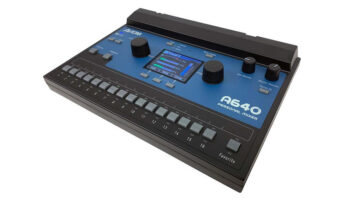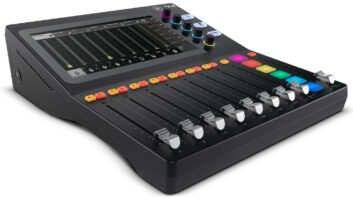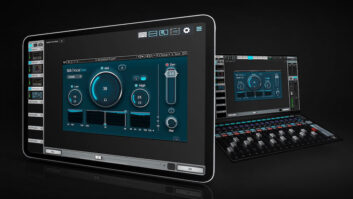For the past 25 years, Speck Electronics has been providing high-quality mixers that address the needs of recording and touring professionals. Throughout the ’70s and early ’80s, at a time when most recording consoles were large, semi-custom models, Speck gained recognition for its 16-input, 8-bus “in-line” consoles. Since the mid-’80s, the company has focused on high-quality rackmount recording mixers. With its new XTRAMIXcxi Ultra-Compact Synth/Line Mixer, Speck has created the only mixer of its type that combines a keyboard/line mixer with an 8-bus recording mixer, all contained in a 4U rackmount chassis.
With 76 inputs, XTRAMIX has an extraordinary capacity for accommodating a wide range of signals (-20 dB ~ +28 dB) from keyboards, samplers, playback equipment and signal processors. This 40x8x2 mixer provides 20 stereo line inputs, eight stereo effects returns and has facilities for 8-channel monitoring. The comprehensive Master section can even be expanded with yet another XTRAMIX by way of a dedicated port on the rear panel.
The XTRAMIX is divided into three primary sections-Input, Effects Send and Return, and the Master Section. On the front panel, each of the 20 stereo input channels has a stereo level control, pan control, buttons for assigning signals to the eight buses, eight effects sends and solo in place. Corresponding with each channel, the rear panel has stereo 11/44-inch TRS balanced inputs, a high/low level select switch (which takes the place of a trim control) and an effects Stereo/Mono switch with a corresponding front panel LED.
The Effects section has facilities for as many as eight stereo effects devices. Each effects channel has a master send for its respective effects bus and an associated effects sum input. The return has a stereo effects return level, buttons for making subgroup assignments, a pan control, solo in place and a mono switch.
The Master section provides considerable flexibility for routing and managing input and effects return signals. This section of the XTRAMIX has eight discrete subgroup level controls with the ability to accommodate 8-track in-line monitoring, in addition to the stereo program, stereo monitor and headphone controls. The stereo cue and aux returns accept a variety of signals that can be mixed with the primary input signals to the monitor and headphone outputs. The Master section provides numerous 11/44-inch input and output connectors to enable the XTRAMIX to integrate into a wide range of production environments.
APPLICATION ENVIRONMENTS
The XTRAMIX makes an excellent mixer for the keyboard player with a sizable rig. With its ability to handle 20 stereo pairs, this mixer is quite capable of accommodating the outputs from synths, samplers and sound modules. As with any true line mixer, the XTRAMIX has no onboard EQ. The DSP processing capabilities of today’s electronic instruments are far more adept at making tonal adjustments than any but the most sophisticated equalization systems-functions that would significantly increase the price of this mixer if they had been included.
The XTRAMIX can also help alleviate a common problem in the recording studio-a primary console that is running out of inputs. The XTRAMIX provides a talkback section with an internal microphone, which is unusual for a line mixer. While it lacks provisions to direct signal to the studio (as is common on a recording console), it has the ability to talk or slate to the program master outputs and the monitor outputs-depending on the status of the associated rear panel Monitor Configuration Switch.
With such a high input capacity, the XTRAMIX also makes a viable tool for high-input sound contractor installations. To gain additional inputs, each of the mixer’s eight monitor positions may be switched to a mono or stereo input. The mixer ships with rack ears that can be attached easily, enabling the unit to be positioned just about anywhere.
It should be noted that the XTRAMIX uses an external regulated power supply. For a compact line mixer, this makes it that much easier to isolate audio lines from any possible noise interference induced by the proximity of the power supply. The power supply does not have an On/Off switch.
THROUGH THE PACES
With such a high number of rotary pots, push buttons, concentric knobs and LEDs in a relatively small surface area, describing the mixer’s front panel as “busy” seems like an understatement. When I first pulled the XTRAMIX from the box, I was astounded. I can honestly say I have never seen a greater concentration of buttons and knobs on any mixer of any size, anywhere. The same applies to the rear panel. With 76 inputs (not to mention the Program, Cue, Monitor and Effects sends), there are so many “holes” in this small box that you can’t help but be impressed with the unit’s design and construction.
The XTRAMIX is a rugged, well-built mixer. Every aspect of this unit has a solid, firm touch that inspires confidence. For this evaluation, I used the XTRAMIX as a keyboard submixer into my recording board. I also patched in a CD player so that I could listen to some of my favorite music and get a feel for how it sounded through the mixer.
After making my connections, I began by playing a CD so that I could check out the mixer’s signal routing functions. Subgroup assignments are labeled in such a manner that one button displays 1-2/5-6 while the button beneath it displays 3-4/7-8. Directly beneath these switches resides another switch identified with a down arrow that functions as the Assign Changeover Switch. With the Assign Changeover Switch depressed, the 1-2/5-6 assign switch routes signal to the 5-6 subgroups. With the Assign Changeover Switch in the up position, the 1-2/5-6 assign switch routes signal to the 1-2 subgroups. This signal routing method is easy to grasp and is used in similar fashion for assigning effects returns, as well as Bus/Line assignments in the Monitor section.
The mixer’s ten-segment VU display meter consists of a series of tiny LEDs that indicate the relative levels of the stereo program and the eight subgroup outputs. The VU display is sensitive from -20 dB to +3 dB. By repeatedly pressing the VU meter select switch, you cycle through the readings of the eight subgroups and the stereo master. This arrangement makes it easy to view the various level settings quickly and easily.
Interestingly, the eight effects send masters are positioned on the mixer’s rear panel. While this seriously limits access to the controls if the mixer is rackmounted, it is a reasonable compromise given the “set it and forget it” nature of keyboard mixing or contractor installations. Assuming you are permanently assigning a few signal-processing devices to your setup, this isn’t likely to be an issue.
For the keyboard player, the XTRAMIX even provides a dedicated feed and level control for use with an external tuning device. This is a nice touch that even ties into the mixer’s Solo functions-enabling you to isolate a particular instrument.
IN CONCLUSION
Throughout my work with the XTRAMIX, I was genuinely impressed with its sound quality. This is a very clean, solidly constructed mixer that passes signal without any noticeable coloration-even when summing multiple input and effects return signals. The fact that the eight effects send masters are positioned on the mixer’s rear panel shouldn’t be an issue as long as your setup is of a semi-permanent nature.
As all its hardware is positioned in such a small area, reading the labeling of these controls can be difficult. Compounding the challenge is the fact that many rear panel functions are labeled vertically. My advice is to have a flashlight handy-even in well-lit rooms.
In contractor installations, the XTRAMIX makes an excellent choice as long as the mixer is going to be locked away, where the curious individual can be prevented from disturbing the setup. I say this because the XTRAMIX is not the most intuitive mixer to use. Its high concentration of narrowly positioned controls makes this unit a challenge until you get accustomed to its layout. While the manual is well-written and provides accurate information about the mixer’s many functions, it assumes you have a thorough understanding of why you would want to use a particular feature. Notes of a tutorial nature would significantly add to the unit’s user-friendliness.
At a direct price of $2,990, the XTRAMIXcxi is a feature-packed, well-made unit that elevates small analog mixers to an entirely new level. Yes, it’s crowded and requires some ramp-up time, but it delivers a lot of capability and sounds terrific. In the end, that’s what matters to most of us.
Speck Electronics, 341 E. Alvarado St., Fallbrook, CA 92028; 760/723-4281; www.speck.com.
